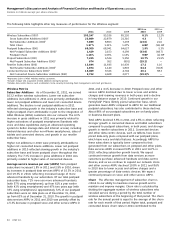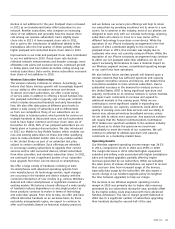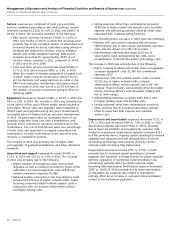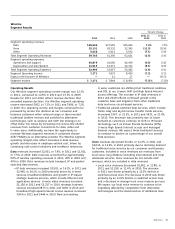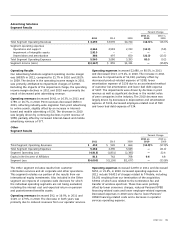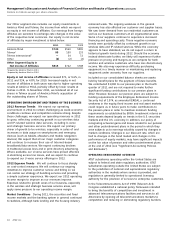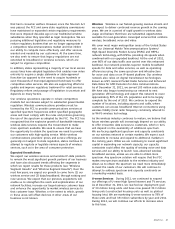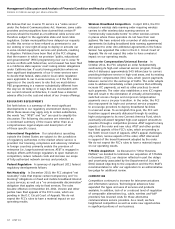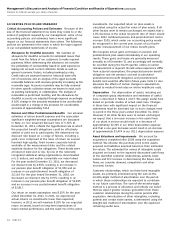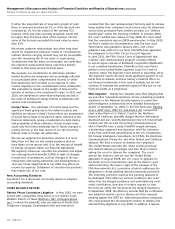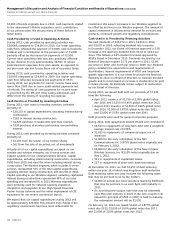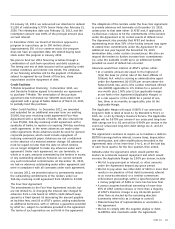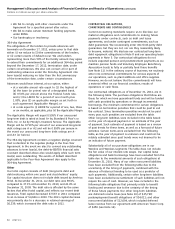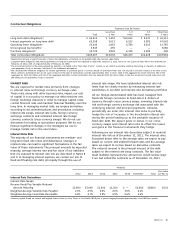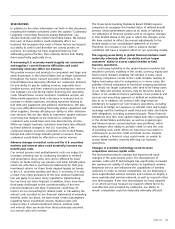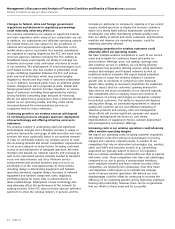AT&T Wireless 2011 Annual Report Download - page 46
Download and view the complete annual report
Please find page 46 of the 2011 AT&T Wireless annual report below. You can navigate through the pages in the report by either clicking on the pages listed below, or by using the keyword search tool below to find specific information within the annual report.
Management’s Discussion and Analysis of Financial Condition and Results of Operations (continued)
Dollars in millions except per share amounts
44 AT&T Inc.
investments. Our expected return on plan assets is
calculated using the actual fair value of plan assets. If all
other factors were to remain unchanged, we expect that a
1.0% decrease in the actual long-term rate of return would
cause 2012 combined pension and postretirement cost to
increase $525, which under our accounting policy would
be recognized in the current year as part of our fourth-
quarter remeasurement of our retiree benefit plans.
We recognize actual gains and losses on pension and
postretirement plan assets immediately in our operating
results. These gains and losses are generally measured
annually as of December 31 and accordingly will normally
be recorded during the fourth quarter, unless an earlier
remeasurement is required. Should actual experience differ
from actuarial assumptions, the projected pension benefit
obligation and net pension cost and accumulated
postretirement benefit obligation and postretirement
benefit cost would be affected in future years. Note 11 also
discusses the effects of certain changes in assumptions
related to medical trend rates on retiree healthcare costs.
Depreciation Our depreciation of assets, including use
of composite group depreciation and estimates of useful
lives, is described in Notes 1 and 5. We assign useful lives
based on periodic studies of actual asset lives. Changes
in those lives with significant impact on the financial
statements must be disclosed, but no such changes have
occurred in the three years ended December 31, 2011.
However, if all other factors were to remain unchanged,
we expect that a one-year increase in the useful lives
of our plant in service would result in a decrease of
approximately $2,325 in our 2011 depreciation expense
and that a one-year decrease would result in an increase
of approximately $3,474 in our 2011 depreciation expense.
Asset Valuations and Impairments We account for
acquisitions completed after 2008 using the acquisition
method. We allocate the purchase price to the assets
acquired and liabilities assumed based on their estimated
fair values. The estimated fair values of intangible assets
acquired are based on the expected discounted cash flows
of the identified customer relationships, patents, trade
names and FCC licenses. In determining the future cash
flows, we consider demand, competition and other
economic factors.
Customer relationships, which are finite-lived intangible
assets, are primarily amortized using the sum-of-the-
months-digits method of amortization over the period
in which those relationships are expected to contribute
to our future cash flows. The sum-of-the-months-digits
method is a process of allocation and reflects our belief
that we expect greater revenue generation from these
customer relationships during the earlier periods after
acquisition. Amortization of other intangibles, including
patents and certain trade names, is determined using the
straight-line method of amortization over the expected
remaining useful lives.
ACCOUNTING POLICIES AND STANDARDS
Critical Accounting Policies and Estimates Because of the
size of the financial statement line items they relate to or the
extent of judgment required by our management, some of our
accounting policies and estimates have a more significant
impact on our financial statements than others. The following
policies are presented in the order in which the topics appear
in our consolidated statements of income.
Allowance for Doubtful Accounts We maintain an
allowance for doubtful accounts for estimated losses that
result from the failure of our customers to make required
payments. When determining the allowance, we consider
the probability of recoverability based on past experience,
taking into account current collection trends as well as
general economic factors, including bankruptcy rates.
Credit risks are assessed based on historical write-offs,
net of recoveries, and an analysis of the aged accounts
receivable balances with reserves generally increasing as the
receivable ages. Accounts receivable may be fully reserved
for when specific collection issues are known to exist, such
as pending bankruptcy or catastrophes. The analysis of
receivables is performed monthly, and the allowances for
doubtful accounts are adjusted through expense accordingly.
A 10% change in the amounts estimated to be uncollectible
would result in a change in the provision for uncollectible
accounts of approximately $114.
Pension and Other Postretirement Benefits Our actuarial
estimates of retiree benefit expense and the associated
significant weighted-average assumptions are discussed
in Note 11. Our assumed discount rate of 5.30% at
December 31, 2011, reflects the hypothetical rate at which
the projected benefit obligations could be effectively
settled or paid out to participants. We determined our
discount rate based on a range of factors, including a
yield curve comprised of the rates of return on several
hundred high-quality, fixed income corporate bonds
available at the measurement date and the related
expected duration for the obligations. These bonds were
all rated at least Aa3 or AA- by one of the nationally
recognized statistical rating organizations, denominated
in U.S. dollars, and neither convertible nor index linked.
For the year ended December 31, 2011, we decreased
our discount rate by 0.50%, resulting in an increase in
our pension plan benefit obligation of $3,384 and an
increase in our postretirement benefit obligation of
$2,114. For the year ended December 31, 2010, we
decreased our discount rate by 0.70%, resulting in an
increase in our pension plan benefit obligation of $3,995
and an increase in our postretirement benefit obligation
of $2,817.
Our return on assets assumption was 8.25% for the year
ended December 31, 2011. In 2011, we experienced
actual returns on investments lower than expected;
however, in 2012 we will maintain 8.25% for our expected
return on assets, based on long-term expectations of
future market performance and the asset mix of the plans’


